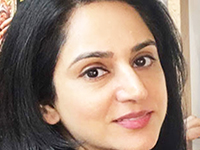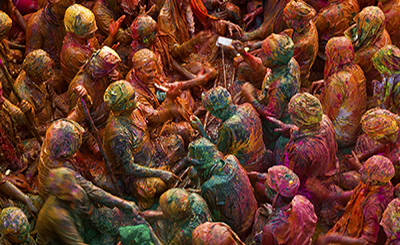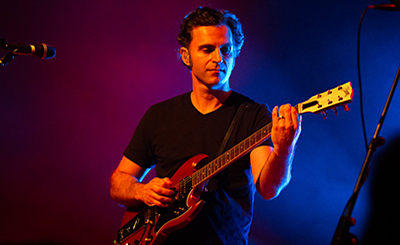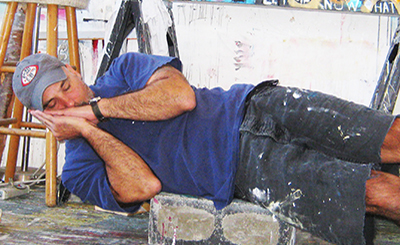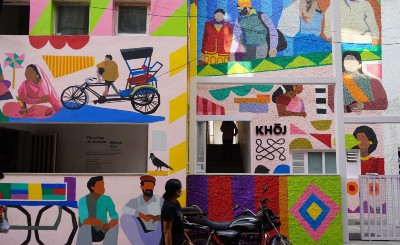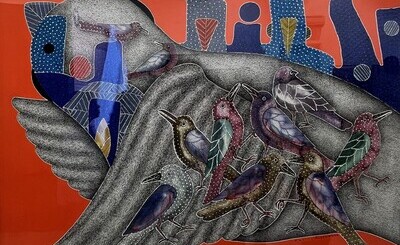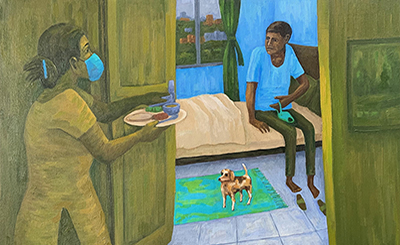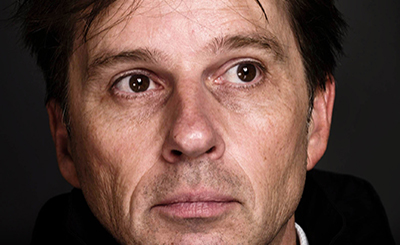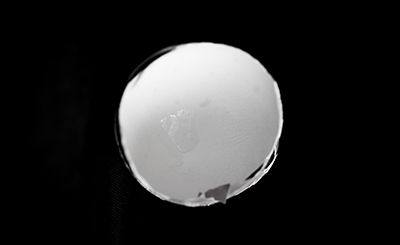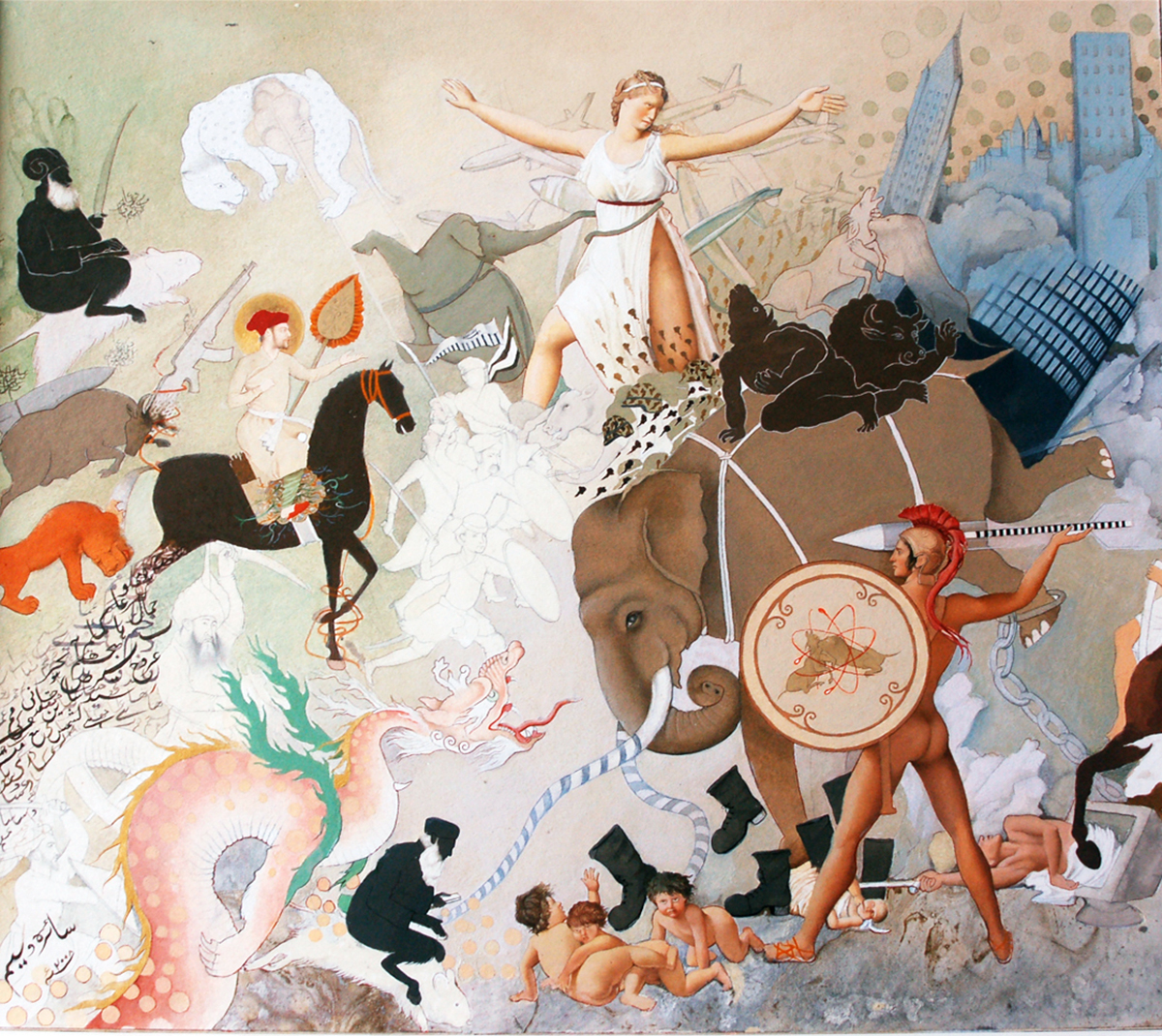
Plea for Peace (detail), 2008-2012, 21.5 x 19.5 inches, Gouache, ink , gold leaf on wasli paper.
Staying at home, reflecting on the idea of home, belonging, life, relationships with others, as well between pain and creativity, loneliness, family time and hatred in the time of pandemic
Chapter 1: Stay Home, Stay Safe
“It was the best of times, it was the worst of times, it was the age of wisdom, it was the age of foolishness … it was the spring of hope, it was the winter of despair.” — Tale of Two Cities (1859), Charles Dickens.
The lockdown has given me time to reflect on myself, my relationships with others, what’s important for me, and how to rejuvenate my life on many levels.
A big salute to the medical and hospital staff, policemen, and every single person who is a part of the combat against COVID-19 as they are our true heroes. My heart goes out to those who lost their loved ones, and couldn’t bid them the final goodbye during this crisis; I am coping with the loss of my cousin-brother due to coronavirus.
Before lockdown, I had this habit of complaining about life, but now, the lockdown has made me realize what a heaven we all were living in and being ungrateful about it. We the Americans had ample opportunities, still we were not content and took many things for granted before.
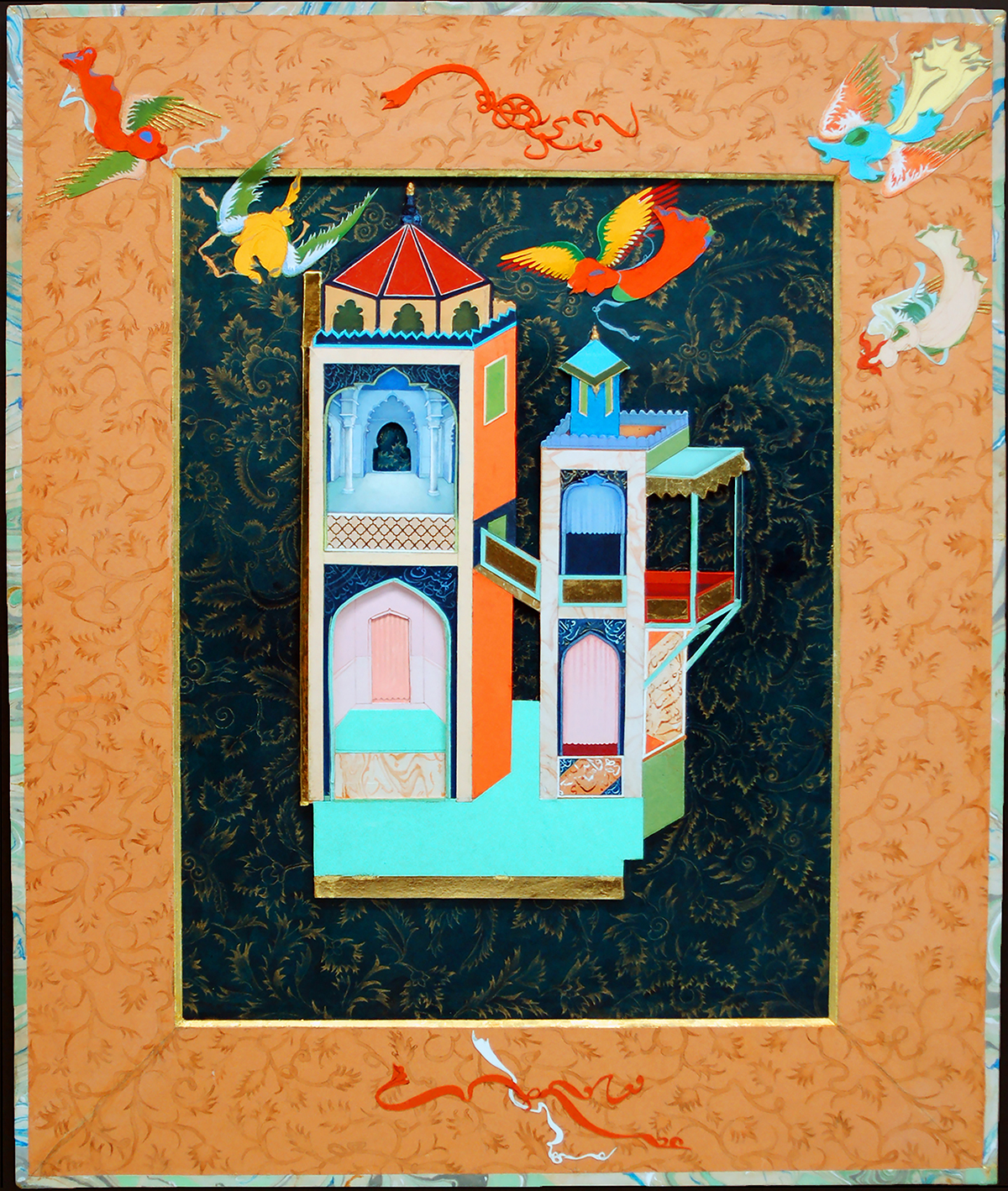
Seek and Find, 2020, 51.5 x 43cm, paper-cut collage, gold leaf, ink and gouache on tea stained wasli paper.
So, this lockdown has taught me to be content with what I have and appreciate even the little things in life. Secondly, we the Americans have this habit of constantly buying. The lockdown made me realise that I could live within my means — de-cluttering and simplifying my life and making a room that matters for me. Walking the other day to Target for a few errands, I noticed how roads, normally brimming with cars, were empty and an unfamiliar quietness filled the air. I saw these white mannequins in the window and they struck me because they had this bland look on their face with the brand new outfits, just staring out from the glass window. It fascinated me because that’s what most of us look like, mindlessly running here and there every day, but where are we going? We have to accomplish this; build this and that; we want more and more, but for what?
We are caught up on the endless treadmill of life — activities have become meaningless and mundane. But, now, we have got this chance to pause, slow down and let go of the unnecessary busyness of life. Every emergency has a lesson trying to teach something, better to learn than to repent later, again. I am reminding myself every day, finding happiness in the smallest of things.
Chapter 2: At Home in Diaspora
Home is a concept I am constantly trying to seek in my new works. What is home? And where is my home?
Most of us believe that home belongs to a city where we live, grow up, or have a family. For others, a home is a place where they were born even if they have lived elsewhere for many years. For many native people, home is their ancestral village or the place where their ancestors are buried.
It’s slightly different for each person, my husband and I relocate after every five years — we are currently residing in Massachusetts.
For me, every time I moved and created a life somewhere new, I combined all the new and old bits and pieces that shaped my new home to fit me. But there’s a constant voice that reminds me I do not belong to this place.
As I am always unsuccessful to form a new home in my second “home,” my first home always shines within me. Nostalgia is a constant struggle — like a chronic disease with no cure. I came to admit, my home was where my childhood school was. But recently, when I went back to Lahore, my childhood town; I didn’t feel like I was heading “home,” nothing was the same, as time had stolen so much from it. I felt even more torn amid these places. I am constantly searching for a location where I “belong”; I lost my home, but I am constantly seeking a state and defining home. Thus, I came to the realization that “home” doesn’t connote house where we live or where we were born but it’s a feeling or a state of transcendence where you find out your identity, or a state of being, or our inner self. Home is a feeling that gives you a sense of safety, protection and gives you warmth — the same feeling a baby gets in the mother’s lap. Now, home has been a process to me to find my internal stillness; what I am and truly meant to be. Home is the feeling of being loved. God is home for me, too.
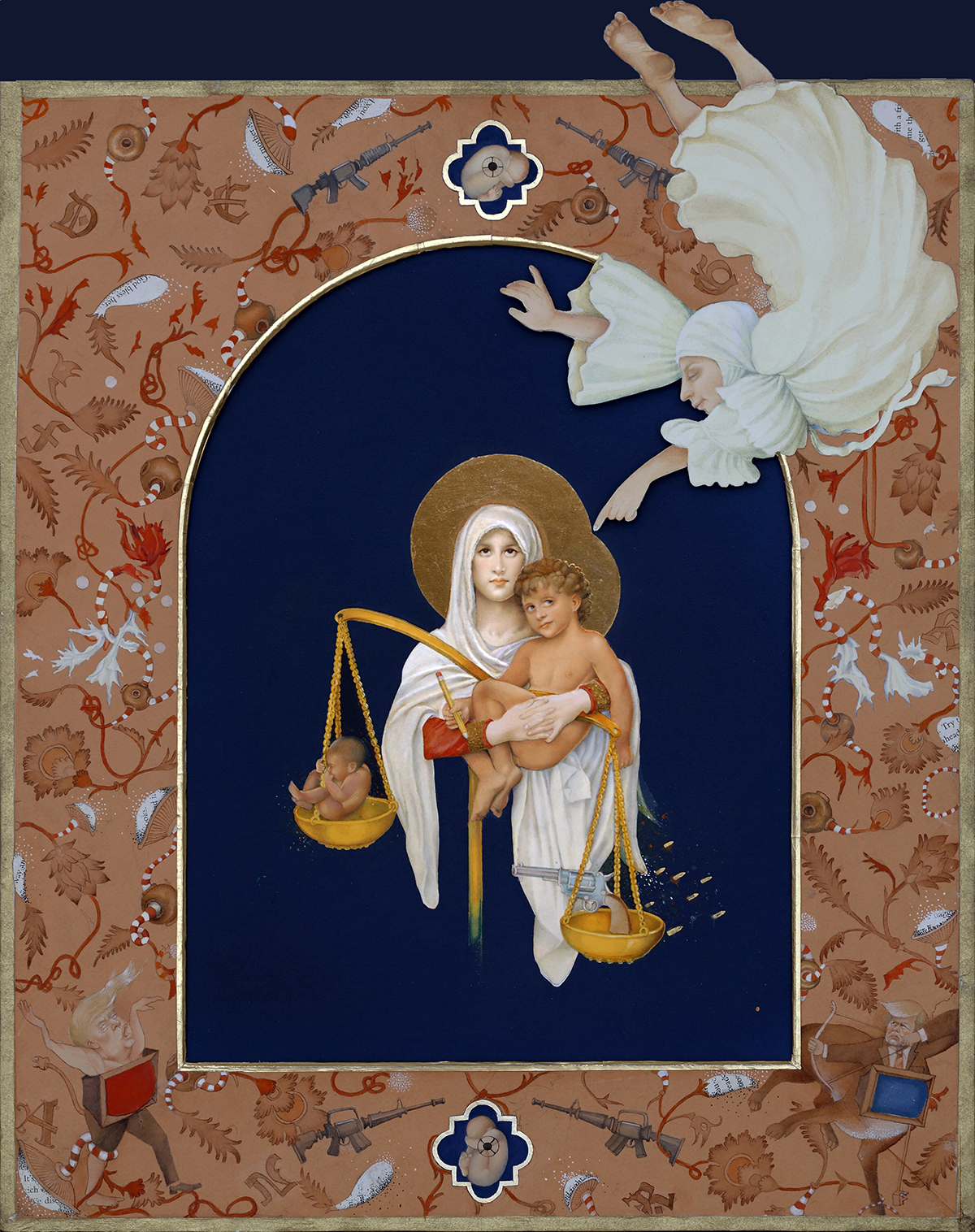
Silent Plea, Series ‘To be continued’, 2018, 51.5 x 43 cm, paper-cut collage, gold leaf, ink and gouache on tea stained wasli paper.
Some people suggest that home, like the Buddha, lives inside of you. “Home is where we find our balance, the pivoting point that connects us to the heart.” Pico Iyer, a famous novelist, stated that ‘home’ has more to do with a piece of your soul, not soil.
My recent works are based on the same concept, my quest to find my 'home'. The series, “Seek and Find’, is based on the same notion, where home serves as a canvas for my self-expression. An attempt or an outward expression of my inner being, my ‘home’, a mirror of my subconscious desires, hopes, fears, and dreams. It’s a reflection of my beliefs and it’s decorated with all those bits and pieces that I have gathered in my inner world. But still, I would echo what Dorothy famously says in The Wizard of Oz, “There’s no place like home.”
Chapter 3: Pandemic Loneliness
This pandemic has brought gut-wrenching loneliness for millions around the world, but let’s not confuse loneliness with being alone. Loneliness is a state of mind of depression and confusion that takes the best of us. Whereas, aloneness, is a state of solitude and meditation where people get in touch with their best being. The best things in one’s life happen when someone is in the state of solitude. It’s a state where we can become self-forgetful and where surprising leaps of imagination and creativity, and talents, can be tapped in your aloneness. Two of the greatest tools in a creative person’s arsenal are the time needed to create and uninterrupted focus. Interestingly, creative people get more productive in quarantine and lockdowns.
Newton discovered gravity in a pandemic; William Shakespeare produced some of his best works, King Lear, during pandemic; Faiz Ahmad Faiz’s beautiful poetry — Dast-e Saba and Zindan Namah — took birth in the prison.
‘Without great solitude no serious work is possible’.~ Pablo Neruda
Sometimes it could be experienced both simultaneously. My experience with my solitude: I crave and find bliss in it but at times complain being lonely.

My husband and I are far away from the place we call “home”. In pursuit of artistic and religious freedom, self-imposed exile was the only option we were left with, along with that change came a large sacrifice: departing from our closest loved ones. As time passes by, we realize that home isn’t just a place. It’s where your people are or is a state of mind.
Living in a town where I feel like a ‘stranger in a strange land’, there is a constant sense of separation from home, in-between-ness, and pressure to blend into the new milieu.
So, Diaspora’s loneliness is ever-present: In some moments, it’s turbulent, in others, it’s there feeling of melancholy, somewhere between sadness and nostalgia. So, my art practice intervenes to be a great antidote in lonely moments and picking up a brush and applying watery strokes on a wasli paper turns to be therapeutic medication and reduces the burden in loneliness. Before lockdown, my talking books/audiobooks give me great comfort in the long hour of working in isolation but with three kids at home it’s impossible to achieve that alone time.
Chapter 4: Lockdwon with Three Kids
It’s the eighth week of lockdown with three kids; and I miss my solitary mornings in my studio. Now, every day, there is a mountain of dishes waiting for me in the kitchen.
It’s 41st day of closed school and the moment I absorb myself in my artworks, my kids are on YouTube.
Since I became the mom of my first daughter in 2006, the battle of my creative and artistic pursuit with my domestic and motherhood obligation continues. I’m both, but very rarely do I feel that I am good enough in either
of those roles… I have become a frantic juggler.
Every day, there’s a feeling I’m losing either one of the two battles — being a good mom and an accomplished artist. I despair when I am not working and blissful while working.
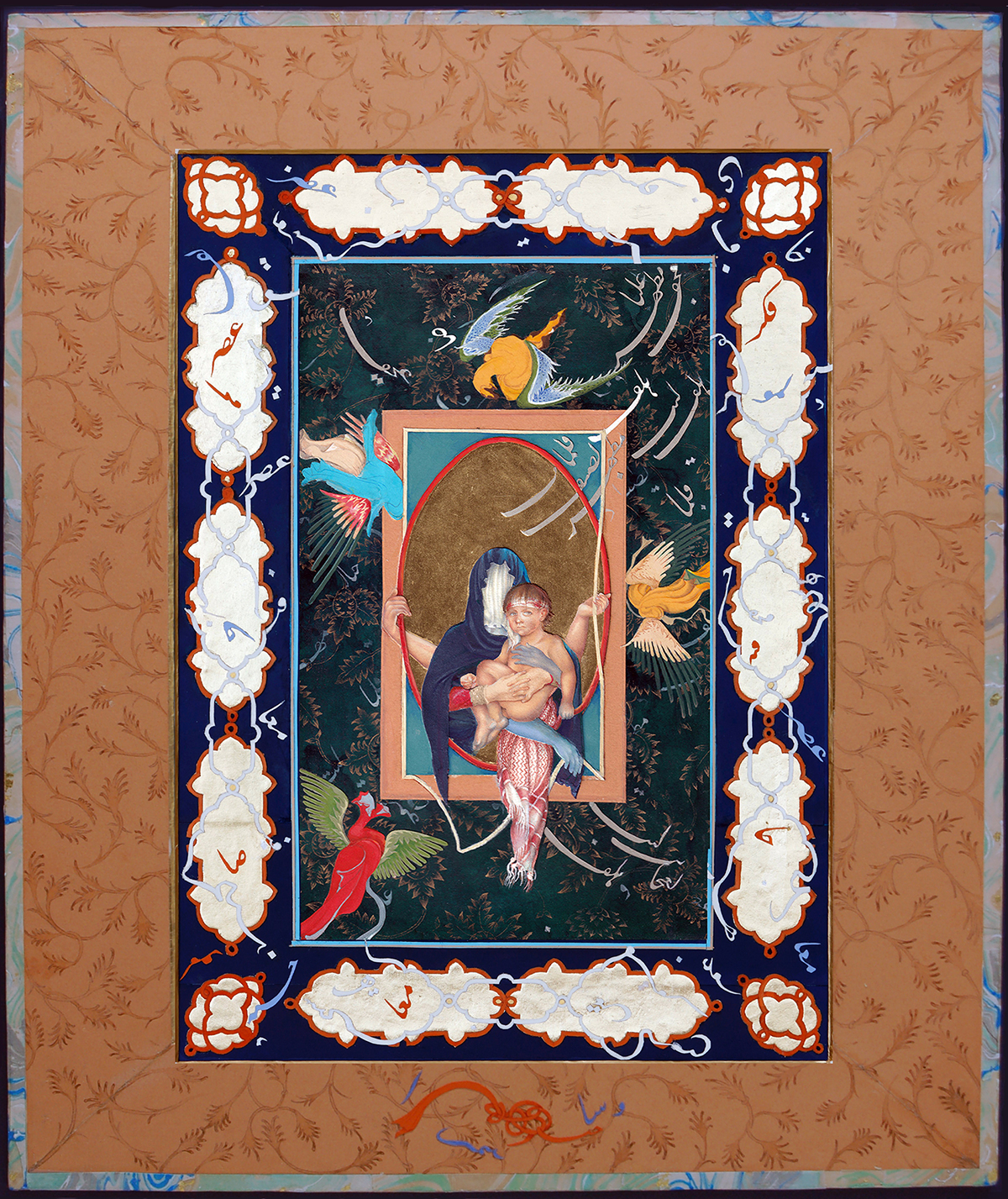
I do Exist, 2020, 51.5 x 43cm, paper-cut, gold leaf, ink and gouache on tea stained wasli paper
Since lockdown has started, there are moments when I feel like I’m dying a little more every day.
Sometimes, there’s a feeling of guilt inside me; I missed parent-teacher meetings, my daughter was unable to submit the assignment as I forgot to read email on time, and so many more…
I’m a better mom when I’m not creating. I’m not painting right now and I’m enjoying the kids more. I’m better at home when I’m painting less.
The feelings of being unfulfilled emotionally and intellectually, and my temporary inability to pursue creative ambition, usher me in the corridors of anxiety and blue mood.
I cannot be present to my family in the way they need and also be fully present to my artwork at the same time.
There is nobody more boring than a career-driven mom who spends endless amount of time with her children while her mind is somewhere else.
I convince myself today — I would be a little bit less of a mother so that I could continue to paint today and then, that familiar guilt.
Chapter 5: Is Pain Necessary for Creativity?
Everyone hates pain, but many creative individuals believe it can be a great motivator. Many experts say sorrow and pain are good for creativity. For instance, in arts, it’s something that is often inspired by profound and deep suffering, and some of the best works in history were created because of it.
History is full of long-suffering creative geniuses who use physical or emotional pain as an art form or to communicate their emotions. The list is so long. Of these, there are celebrated artists who chose not to recoil in passive suffering. Instead, they turned their sorrow into something the world would cherish.
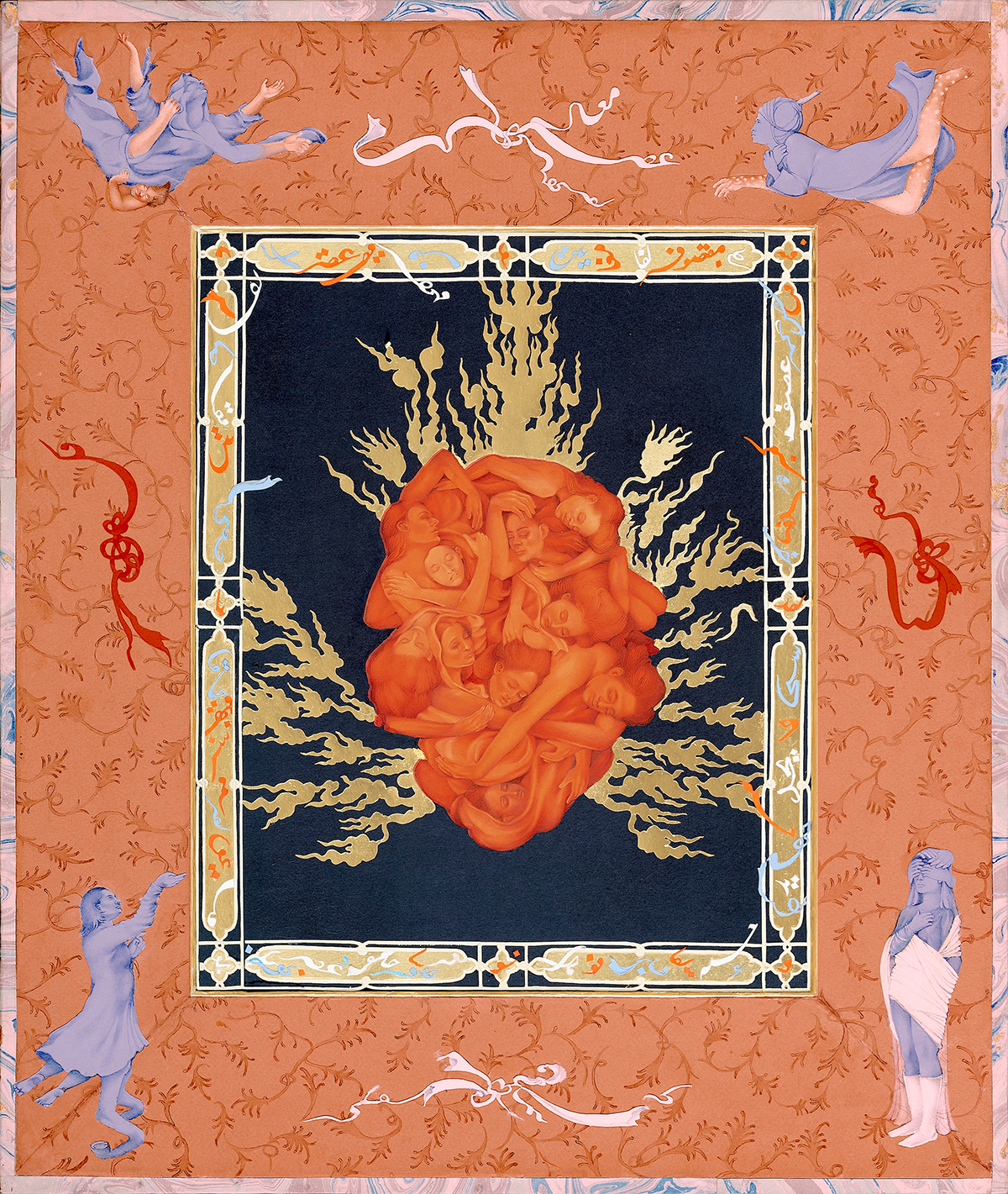
We Sinful Women I, 2019 51.5 x 43cm, paper-cut collage, gold leaf, ink and gouache on tea stained wasli paper.
Over the past couple of generations, clinical research indicates that creative people in arts-related professions endorse higher rates of mental issues than non-arts professionals.
In fact, that it has become normal to see suffering and melancholy as an essential ingredient for art. Many Western artists romanticize ‘tortured artists’ myth, its commonly-known stereotype, that artists require (or should seek out) turbulence to create meaningful art. Many believe there is a direct connection between artists and mental illnesses. Many artists use medicine to smooth things over. They drink or take pills or whatever they do to deal with the painful sides. But so do people who don’t produce art. It’s not like only artists drink to cope with their pain. Doing so doesn’t make you more interesting or creative — and it may even destroy you.
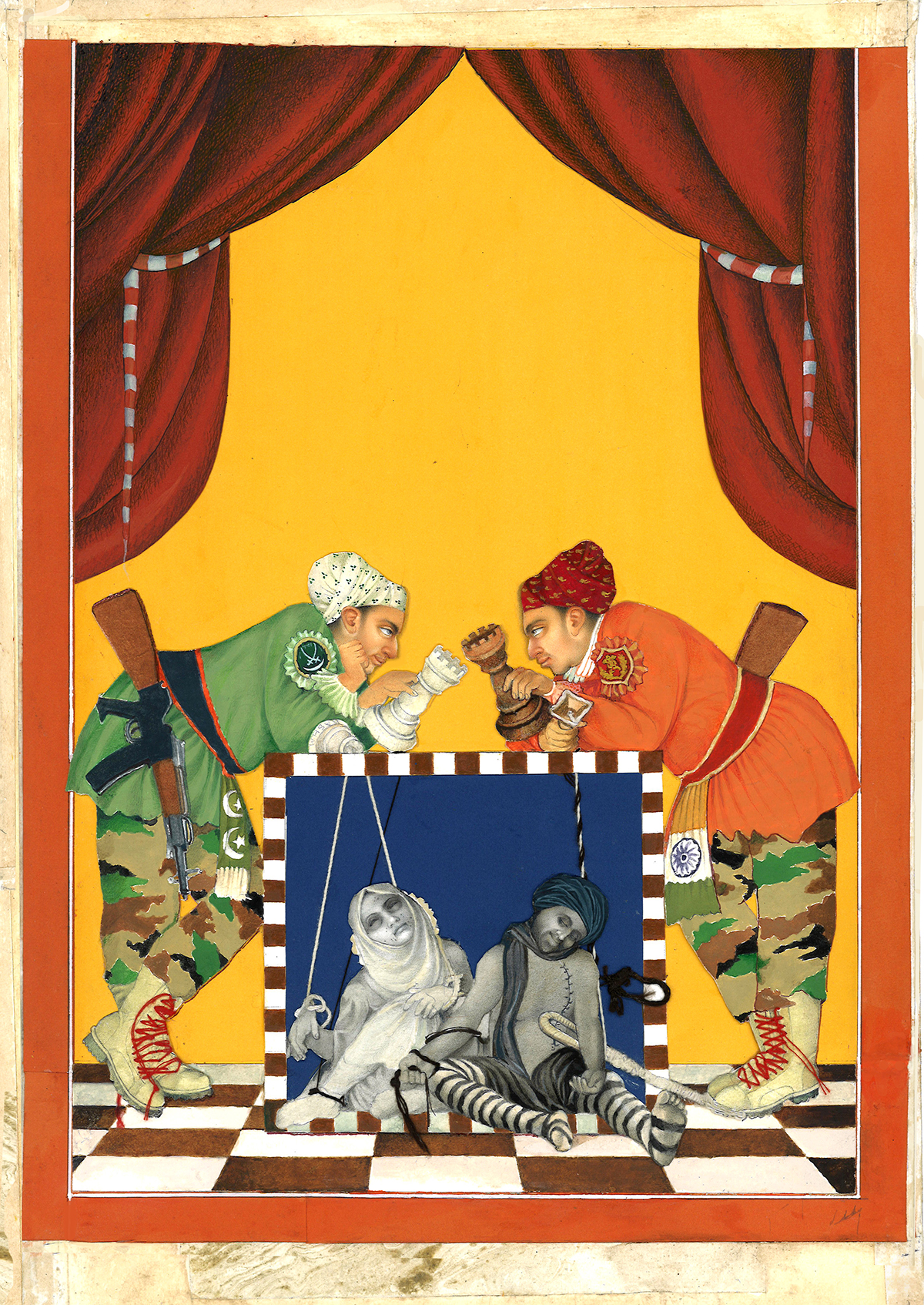
The Greatest show on Earth, 2016, 24.5 x 33cm, Mix media, threads, paper cut collage and gouache on wasli paper.
But any mental illness, depression, or addition can sabotage one’s creative process. You don’t have to be tortured to be an artist, or if an artist is not suffering, they can’t add that much value to their work. Even if people in creative fields are suffering from depression, trauma, suffering or illnesses there’s an enormous amount of pressure on the artists when they’re constantly told that their sense of self-worth and productivity is tied by coming up with something ‘new’ or ‘being different’, or ‘being more creative’ and when your whole livelihood depends on it, it can be pretty stressful to deal with.
When it comes to fostering artistic genius, a rich inner world is crucial that depends on tranquility and calmness of mind.
I very strongly believe that any valuable art doesn’t always come out of suffering or angst but when artists use any creative process as a way of coping or learn to manage their intense emotions. Art becomes beautiful during the inner transformation of an artist through the act of creation.
Art-making connects you with the present moment and any kind of joy, peace, and creativity resides beyond the thinking mind.
Chapter 6: Hate-demic during Pandemic
Humanity might find a cure for COVID-19 very soon. However, there is another virus far more deadly and destructive, and we lack to respond to its threat. I am referring to hate-virus. Its symptoms are bigotry, racism xenophobia, and intolerance against religious minorities.
The virus has unleashed a tsunami of hate across the world during quarantine. In many pockets all over the world, people are pointing fingers, driven by their fears and anxieties to go after ‘the others’. The hunt for blame continues to prevail. US President Donald Trump shocked the world when he kept calling the coronavirus a Chinese virus. As a result, racism aimed at Asian Americans has accompanied the virus. Similarly, Indians are blaming Muslims in many parts of India. A leading Pakistani cleric blames liberal women and obscenity for the coronavirus.
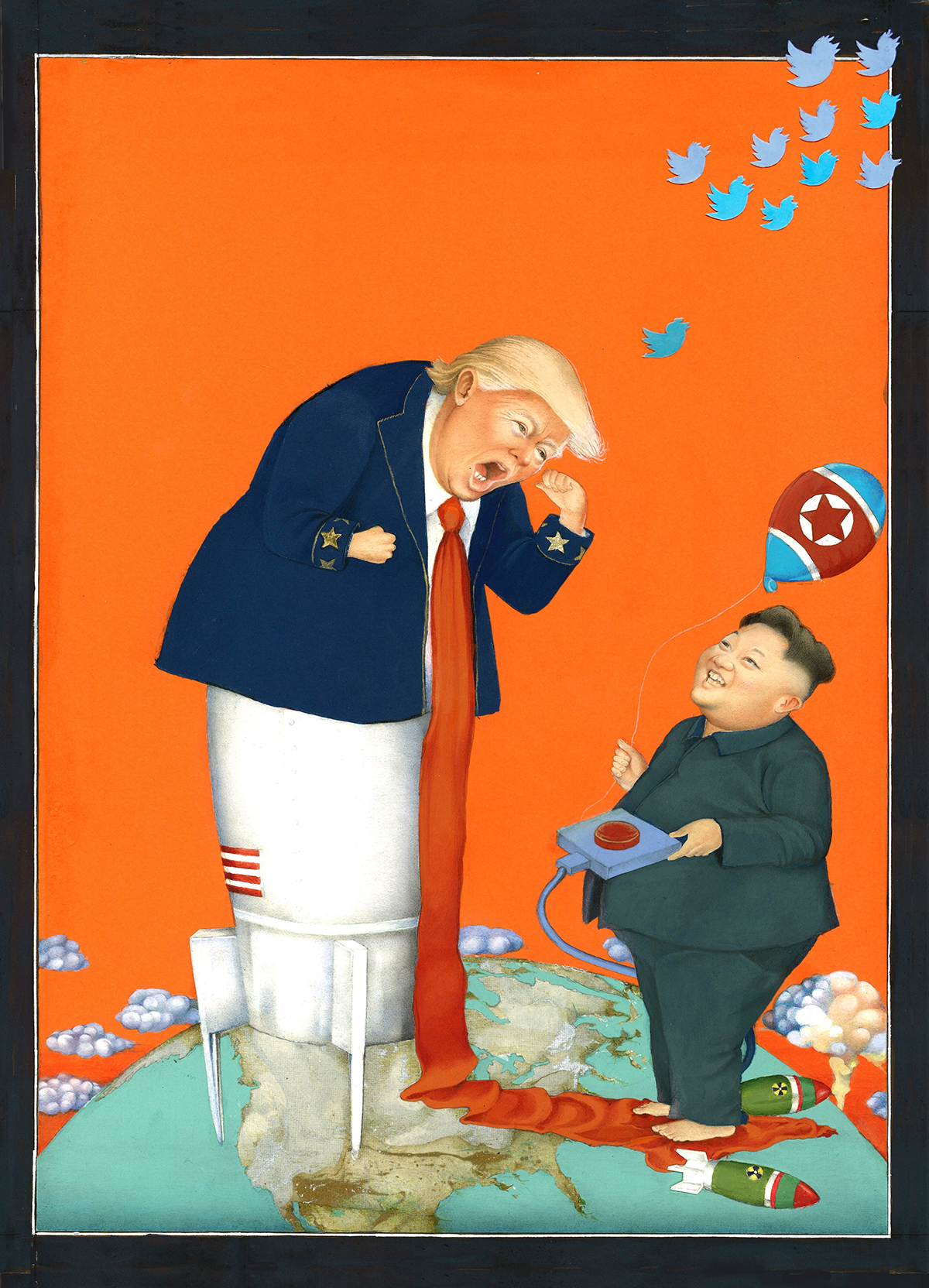 My Button's Bigger than Yours, 2018, 27 x 38 cm, paper-cut collage and Gouache on wasli paper.
My Button's Bigger than Yours, 2018, 27 x 38 cm, paper-cut collage and Gouache on wasli paper.
It is already one of the worst times to be Muslims in India and even worse being Ahmadi in Pakistan.
In this global pandemic, on the one hand we are praying and asking help from God to overcome this crisis, on the other, we literally tear others apart who are different from us.
Regardless of the world under lockdown, there has been a continuation of religion-based hate speech. Many online social platforms normalize hatred and contribute to the dehumanization of others.
Extremist Pakistanis are infected with another virus — the ‘hate virus’. COVID-19, spreading in South Asia, is sparking intolerance towards their religious minorities. The virus and the new wave of hatred have changed everything.
This piece is a part of our special issue on Art in the time of Pandemic, curated by critic, author and one of our contributing editors, Ina Puri
More from Arts
Comments
*Comments will be moderated
I like the work and your thoughtful write-ups, enjoyed reading chapter 5 especially, the "unknown" pain and sorrows, loneliness and the silence
Shahid w khan
Jun 20, 2020 at 02:17



